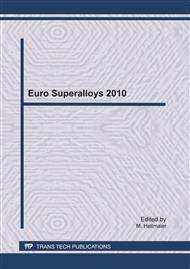p.210
p.216
p.222
p.228
p.234
p.241
p.247
p.253
p.259
Continuum Damage Mechanics Modeling of Creep in DS GTD-111TM Superalloy
Abstract:
Safe extrapolation of short-term creep data requires development of creep models where (a) the constitutive laws are physics based, and (b) majority of model parameters are calculated rather than empirically fitted. This paper details the structure of such a physics-based creep model and its application to DS GTD-111TM superalloy. The constitutive creep law is derived from the kinetics of dislocation-particle interactions in the presence of thermal activation. This constitutive creep law is further coupled with the evolution kinetics of controlling microstructural parameters and associated damages. The model is expected to provide vital inputs for component design as well as remaining life assessment. (GTD-111TM is a trademark of the General Electric Company).
Info:
Periodical:
Pages:
234-240
Citation:
Online since:
July 2011
Keywords:
Permissions:
Share:
Citation:


